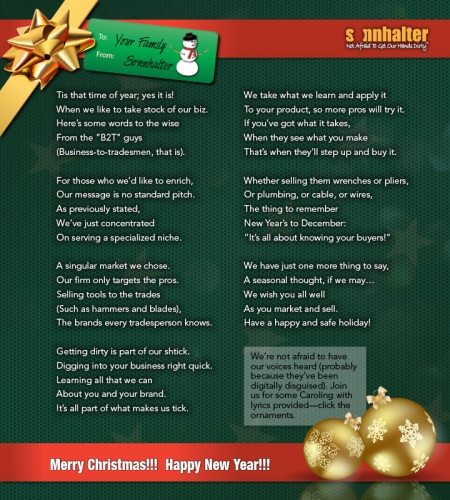by tradesmeninsights | Apr 25, 2013 | Uncategorized
April 25th is set aside each year to honor plumbers. At Sonnhalter, we have a great appreciation for plumbers and the work that they do. Today, Sonnhalter’s PR Engineer Rachel Kerstetter will be sharing with you about plumbing.

Often plumbers don’t receive the credit and fame that they deserve unless they’re Mario and Luigi and trying to save a princess. The Super Mario Brothers are the most famous plumbers, and they live in a Nintendo game.
The reality is that without plumbers, our world would be far from sanitary or pleasant. As part of our team’s commitment to getting our hands dirty in our clients’ work, we’ve had the opportunity to see plumbers at work, we’ve used their tools and we’ve heard their stories; we know that they deserve to be honored today.
Plumbers do much more than unclog drains and fix leaky faucets – it’s plumbers who install the miles of piping that make hot, cold and process water and gas utilities possible. Using a little research combined with our knowledge of the profession, we’ve put together a list of things you may not know about plumbing:
- The word “plumber” goes back to the Roman Empire and the Latin word “plumbum” for lead.
- It’s because of a plumber that the Chicago River is dyed green every St. Patrick’s Day. The river was first turned green in 1962 using plumbing dye for detecting leaks. (more of that story here)
- The ancient Egyptians had plumbing systems. Archeologists have found lavatories inside tombs as well. (more on that here)
- Since 1963, more than 28 billion feet, or about 5.3 million miles, of copper tubing has been installed in U.S. buildings.
- In 2004, there were more than 91,000 miles of water distribution piping in the U.S. 78% of that pipe is made of PVC.
- In 2011, there were approximately 555,900 plumbers and pipefitters working in the U.S. (via the 2011 Encyclopedia of Careers and Vocational Guidance)
- Plumbers install and repair pipes for water, but also for: steam, air and a variety of liquids and gases.
- Toilets have saved more lives than any other invention.
- Thomas Crapper did not actually invent the toilet. Sir John Harrington actually invented the first flush toilet. (more on that here)
- Thomas Crapper owned his own plumbing shop in London by the time he was 25 and was awarded nine patents for plumbing innovations during his lifetime, three of them consisting of improvements to the flushing toilet.
- Plumbers installed 2,500 toilets and 2,500 sinks in the Empire State Building. The building also has 70 miles of pipe (more on that here).
Today we salute the ones who keep everything flowing, and not overflowing. We’re thankful for the dedicated plumbers who answer the call and don’t recount the tales of what they’ve pulled out of pipes.
by tradesmeninsights | Apr 18, 2013 | Uncategorized
Each month we’ll be featuring a blog post from our friends at MAGNET (Manufacturing Advocacy & Growth Network). MAGNET’s mission is to support, educate and champion manufacturing in Ohio with the goal of transforming the region’s economy into a powerful, global player. You can visit MAGNET online at manufacturingsuccess.org.
This post originally appeared on MAGNET’s Manufacturing Success blog and is reposted with permission.
Fail Fast, Fail Cheap
By Robert Schmidt, Growth & Innovation Advisor, MAGNET
We need to be innovative—you know, try new things! Building on those that seem to work and quickly eliminating those that don’t work out as we had envisioned.
The proven method I use in this case would be the “Fail Fast, Fail Cheap” (FFFC) method.
How do we go about this? Simply stop spending time and money on developing new processes, products, or marketing messages without trying it out. You want to find out if your concept is a good one? Find out in a fast, easy, and inexpensive way. Bottom line is: The key to fail fast fail cheap is to spend minimum resources to get the concept off the paper (or your mind) and into the application so you can tell if it needs to be changed, destroyed, or finalized.
FFFC follows Demings “Plan, Do, Study, Act” model. In a rapid succession of learning cycles you try out your idea, learn from that experience, modify and try again- all on a shoestring budget. Fast trumps elegant early on.
An example would be to develop a look-alike or “Frankenstein” prototype made from on-hand or commercially available materials. The Frankenstein prototype gathers critical feedback from potential customers/users. Their reactions (likes, dislikes, concerns) help you determine if investing further resources makes sense and guides your step of development. Its much like taking on an entrepreneur mindset, forcing creativity and short time goals due to a limited budget.
Do you have a proven system for testing your new ideas? Let us know!
Want to learn more about the FFFC method? Contact Linda Barita at 216-391-7766 or visit MAGNET’s Product Design & Development landing page to learn more about how our engineers can help you learn how to “Fail Fast, Fail Cheap.”
Click here to read the original post.
by tradesmeninsights | Mar 19, 2013 | Marketing Tips, Marketing Tools, Social Marketing, Uncategorized
If you’re a manufacturer that either doesn’t use or think social media should be a part of your overall marketing plan, this webinar is for you.
We will discuss why social media is not only relevant but crucial to your overall marketing initiatives. I will be joined by Greg Habermann, COO of SageRock, a digital marketing agency and a strategic partner of ours. We will show you real examples of what manufacturers are doing right and give you tips on how you can too. We’ll focus on YouTube, Slideshare, LinkedIn and Blogs.
When: Tuesday, April 9th at 2PM EST
This webinar is available for viewing on our YouTube channel – click here.
by tradesmeninsights | Feb 13, 2013 | Uncategorized
We generate leads from more sources today than ever before. So is that the good news or the bad news? The key isn’t necessarily in the number of leads, but the quality. So how do you determine and define them? At the end of the day, all anyone cares about is the sale, right?
Unfortunately all leads aren’t created equal. Depending on the market you’re in, 60-75% of all leads aren’t ready to buy! Note I didn’t say wouldn’t, but not ready. That’s why email is an effective and cost efficient way of moving contractors through the funnel.
There are several thing you as a manufacturer need to consider:
- Some of your audience don’t know who you are.
- Some may know who you are but have never done business with you.
- If you’re introducing a new product that the industry has never had, there needs to be a learning curve in most cases before someone will try it.
- If your product is similar to something others already make and has industry acceptance, you have a chance of someone trying yours.
- For bigger, more complex sales, it takes longer to move the prospect through the sales funnel.
Let’s take an example of a contractor. I don’t care if he’s a general, plumbing, HVAC or landscaping contractor as their work lives pretty much run in parallel paths. If they are using day-to-day materials to do a job, they are more prone to try something from another manufacturer.
But if it’s a major piece of equipment like a diagnostic camera, snow plow or other major piece of equipment that they use on a regular basis, they need to consider options before buying. Now let’s consider a few things on a major piece of new equipment.
Chances are, if it’s a replacement for an existing piece that’s 5-7 years old or older, the technology probably has changed dramatically and they will need to go through several steps to get them far enough down the sales funnel to turn the lead over to sales.
Here are some steps he might take:
- Collect info on your product as well as competitive ones
- Review features and benefits
- Read customer testimonials on how well your product works
- Consider asking for a demo
So where in these steps do you think we should get the sales force involved? If you get them involved before the demo stage, you’re wasting their time. The first 3 steps can be handled via emails.
Remember, salesmen want the sale now and don’t have the patience to nurture the lead along. That’s why marketing should take the lead in identifying and taking them through the sales funnel before handing them off to sales, and email marketing is an ideal way to communicate with the contractor and professional tradesmen. Think about this. If we can hand off a lead that’s ready to buy, don’t you think the sales staff will start taking the marketing department seriously? One of my biggest challenges is to get sales and marketing to work together.
Does lead nurturing make sense to you? Would it surprise you to learn that up to 70% of companies don’t have lead nurturing processes in place. It amazes me that companies spend tons of money getting a lead and virtually nothing on nurturing it.
Here are some other posts you might find useful:
5 Tips on Improving Your Email Marketing to Professional Tradesmen
Email Marketing: How Are You Using it to Reach the Professional Tradesmen
by tradesmeninsights | Jan 22, 2013 | Uncategorized
 For those of you who plan on attending the AHR Expo later this month in Dallas, we’ve created a guide to get you around the town during your free time and to entertain those important customers.
For those of you who plan on attending the AHR Expo later this month in Dallas, we’ve created a guide to get you around the town during your free time and to entertain those important customers.
The guide includes recommendations from our friends who live and work in Dallas on the best restaurants, night life and sightseeing. We’ve even included phone numbers of taxi companies just in case you don’t want to drive.
We hope you have a great show and hope to see you either at the convention center or one of the establishments listed in the guide.
Click on the image above to get to the guide.
by tradesmeninsights | Dec 21, 2012 | Uncategorized
I’ll be taking some time off and will be back after the first of the year. Enjoy the Holidays with your Family.



